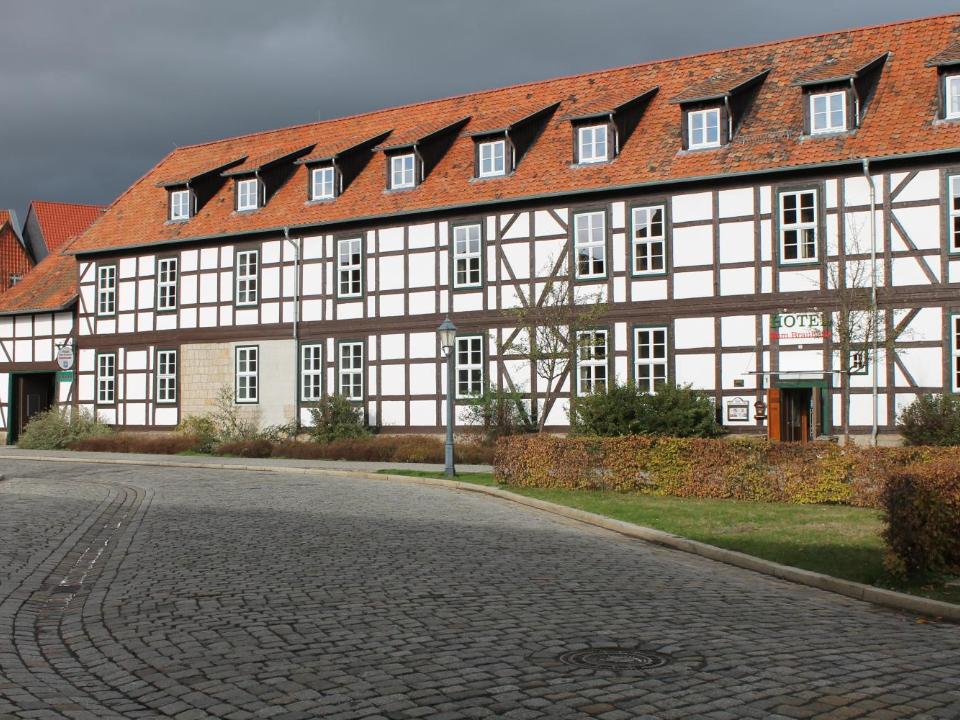Going on a Quedlinburg trip and want to know all the best things to do in Quedlinburg? We have you covered! Below, you will find our guide to all the best attractions in Quedlinburg to plan your ultimate trip.
Quedlinburg made my must-visit list as soon as I saw photos of its amazing Old Town and, if you love Old Towns, Quedlinburg’s is hard to beat. In fact, it’s far and away my favourite one in Germany and, as an Old Town junkie, I have been to a lot!
One of the best preserved Medieval and Renaissance towns in Europe (according to UNESCO who added it to their World Heritage List), you’ll really feel like you’ve gone back in time wandering around here. All the well-preserved half-timbered buildings (over 1300 of them!) are a delight and it’s fantastic to just walk around and explore. Every street seems to beat the last.
If that’s not old enough for you, just look at the buildings on Castle Hill (Schlossberg) which will transport you back to the 10th – 12th centuries. Add in the beautiful Marktplatz and cobblestone streets and I felt like I was in a Medieval fairy tale.

While Quedlinburg can be popular on weekends and in summer, it’s still not crazy busy. We visited in August and it was mostly tourist free! Even if it was busy, it would still a great place to spend a few days soaking it all in. It’s one of my favourite places in Germany and I can’t believe I hadn’t even heard of it a few years ago. Make sure it’s on your Germany itinerary.
Below, you will find our full Quedlinburg travel guide with everything you need to know about the best places to visit in Quedlinburg as well as the best places to stay for your ultimate vacation in Quedlinburg. There is also a handy map of all the things to do Quedlinburg offers.
You’ll also find special sections on things to do in Quedlinburg in December and a full itinerary for a Quedlinburg day trip as well as what works if you are travelling with kids.
There’s a lack of information about Quedlinburg in English which is a shame as everyone should want to visit here. This guide will help!
Traveling to Germany? Click here to download your free Germany Trip Planning checklist. We’ll help you get ready for your trip!
An Introduction To Quedlinburg
Lying on the Bode River in the foothills of the Lower Harz Mountains in the state of Saxony-Anhalt, Quedlinburg was founded in 922 by King Henry I as a fortress. It already existed before this at least as early as the 9th century when a settlement called Gross Orden was on the eastern bank of the river.
The story goes that Henry I was offered the German crown by Franconian nobles at this location in 919 and that the town was then called the “cradle of the German Reich”.
It became a favourite of Saxon Emperors and Henry I and his successors made it an important centre of politics.
Henry I was buried here at Castle Hill when he died in 936. After his death, his widow, Queen Mathilde, founded a women’s religious community on Castle Hill where noble women could be educated. It’s also called the Collegiate Church in Quedlinburg Abbey and you can visit it today.
In 994, the King of Germany, Otto III, gave Quedlinburg the rights to establish the first market place to the north of Castle Hill as well as the rights to tax and mint coins. Quedlinburg grew and prospered.
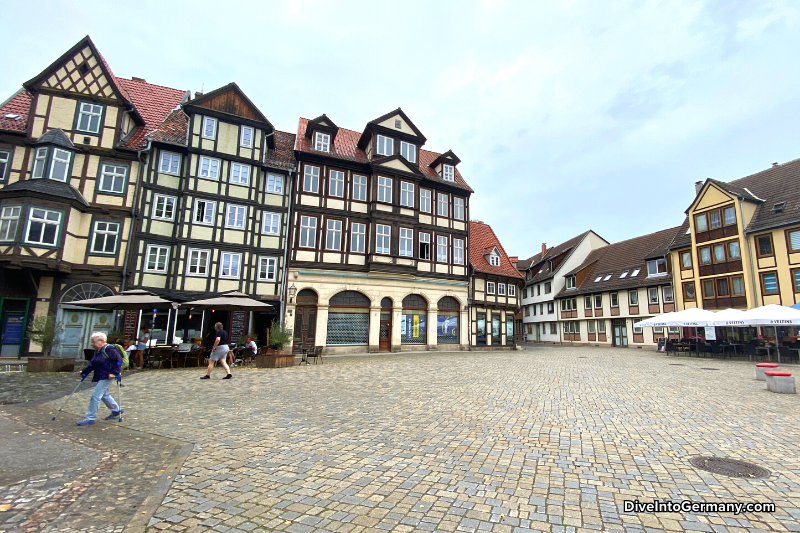
In 1426, Quedlinburg joined the Hanseatic League and wanted to become a free imperial city. However, this did not last long thanks to Quedlinburg Abbey disputing the independence of the town which it wanted to keep under its power.
In 1477, this lead to Abbess Hedwig (the head of Quedlinburg Abbey) winning her resistenace effort against the people who wanted to stay in the Hanseatic League and the Bishop’s forces. Quedlinburg had to leave the Hanseatic League. Instead, it was protected by the electors of Saxony.
During the Protestant Reformation, the town and the abbey converted to Lutheranism in 1539.
In 1697, the Saxony Elector, Frederick Augustus I, sold his rights to Quedlinburg to Brandenburg. In 1802, the abbey was secularised and taken over by the Kingdom of Prussia.
During the Nazi rule, the memory of Henry I became popular and the Collegiate Church and castle became a shrine for their vision of Nazi Germany. Quedlinburg escaped major damage from World War II but was occupied by the Americans during the last months of the war who put the church back how it was.
Quedlinburg was part of East Germany from 1949 to 1990 and joined the state of Saxony-Anhalt when Germany reunified in 1990.
In 1994, the Old Town, the Castle and the Collegiate Church were UNESCO World Heritage listed. This is thanks to Quedlinburg being one of the best preserved Medieval and Renaissance towns in Europe especially because of the number and quality of the timber-framed buildings in this town.
Today, tourism is an important industry in Quedlinburg along with the manufacturing of dyes, engineering products, vehicles, plastics and paper. It’s also a centre of plant research.
Top 11 Things To Do In Quedlinburg Germany
Here are the best Quedlinburg attractions. Read through and select the ones that fit your interests and timeframe. If you only have one day to visit Quedlinburg tourist attractions, find our one day Quedlinburg places to visit itinerary below.
Note that I sort these things to do in Quedlinburg Germany based on geographical location starting with the central Old Town and Marktplatz and then listing the closest Quedlinburg Germany things to do while working our way further away. The order isn’t based on what I think are the most important attractions.
Altstadt (Old Town)
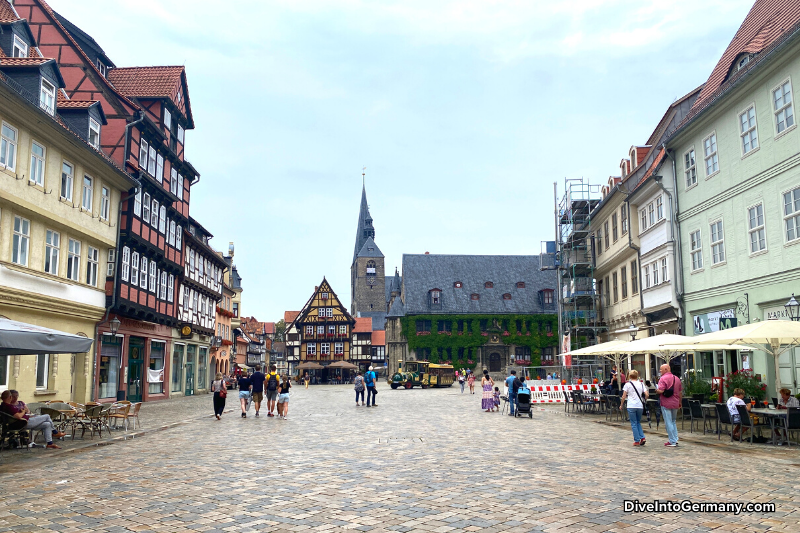
The Old Town in Quedlinburg is absolutely superb and you won’t want to miss it. With the crazy amount of original half-timbered houses, you’ll feel like you’ve gone back in time and there are constantly new buildings to admire as you walk around.
While the buildings you see were built over many different times, the majority of timber-framed houses were built in the economic boom from 1620 to 1720. This style of building was most popular then and a number of special styles developed in Quedlinburg (learn more at the Half Timbered Museum coming up in this list!).
The Old Town is best explored by foot. Marktplatz can be considered the centre and is definitely somewhere to head – it’s gorgeous! – but you’ll no doubt enjoy walking around any of the streets in this area.
The platz in front of Klopstockhaus is another pretty place to wander around, and I particularly enjoyed a line of houses near the corner of Carl-Ritter-Straße and Word as well.
I recommend you take your time wandering the whole area while you slowly tick off any of the Quedlinburg attractions below that interest you.
And keep your camera handy! I took a crazy amount of photos and all were insta-worthy.
There are also some great parks in the Old Town. Perfect for picnics or taking a time out from sightseeing.
Rathaus (Town Hall)
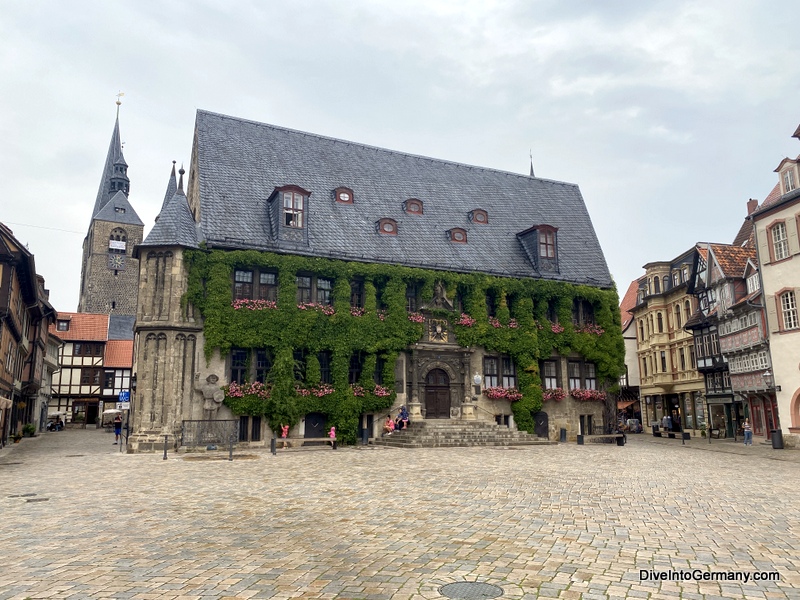
The ivy-covered Rathaus on Marktplatz is something you won’t want to miss. Dating back to 1320, this stone building in Gothic style makes for quite a sight.
Above the door is the city’s coat of arms. You can also see the Roland statue from around 1426 at the front (pictured above on the left hand side). This is from when Quedlinburg joined the Hanseatic League.
This became a controversial figure when Quedlinburg left the league and it has been moved several times, destroyed and re-erected again.
Marktkirche St. Benedikti (Market Church Of St Benedict)
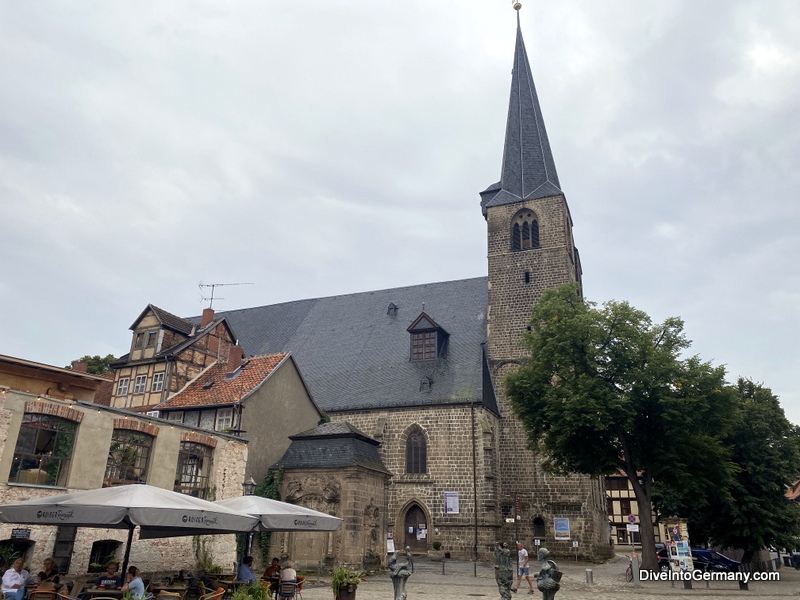
Located behind the Rathaus is Marktkirche, the place Quedlinburg’s merchants went in the 10th century to worship.
With Romanesque stonework, it’s a beautiful building that could have been consecrated as early as 1173. It’s evolved over the years and today, it has many architectural styles and furnishings. It’s worth taking a look inside.
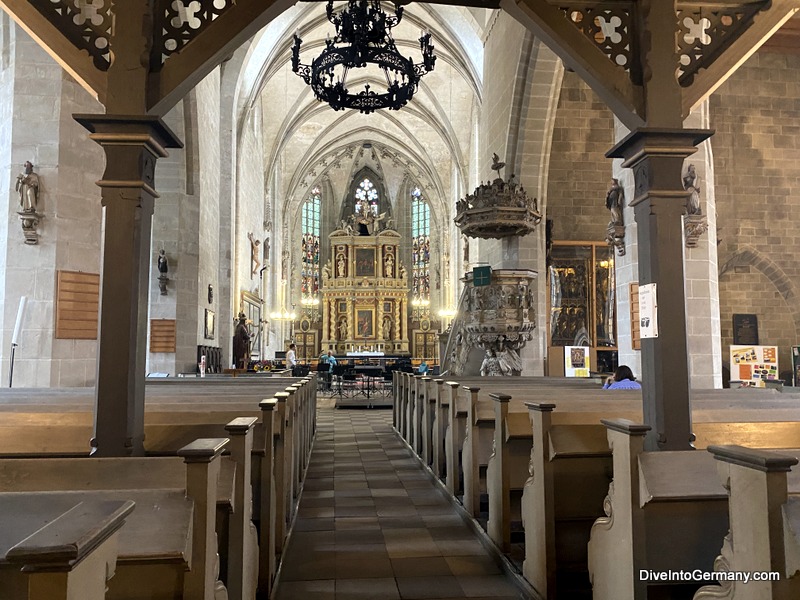
There is a permanent exhibit to enjoy, Quedlinburg – from Palatinate city to Roland city. It looks good, but unfortunately, it’s only in German.
The two towers of the church were damaged by fire which is why today one is lower. At the time of publishing, it is not possible to go inside the towers.
Entry is free.
Sternkiekerturm (Lindenbein Tower)
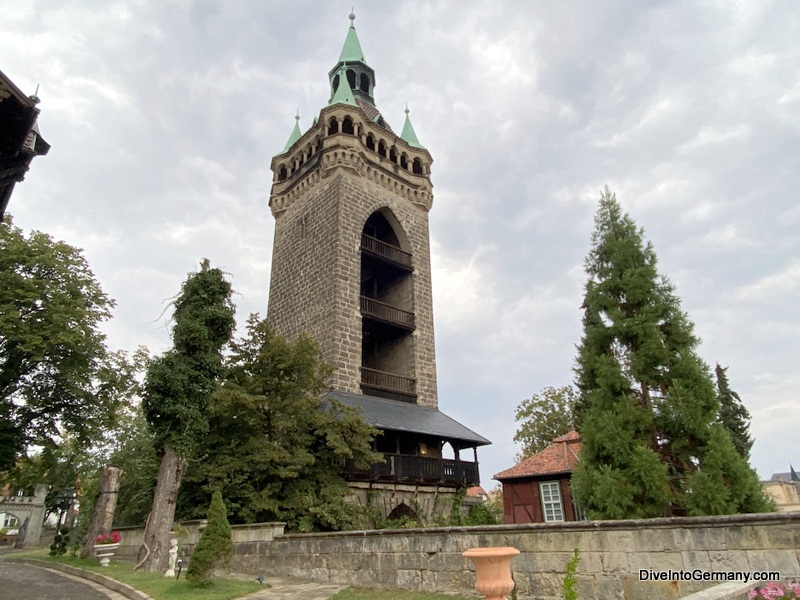
Just to the north-west of Marktplatz is Sternkiekerturm, an observation tower with great views of the Old Town thanks to being 42 metres high.
It is next to the city wall and used to be part of the defensive system of Quedlinburg. The current design of the tower dates to the late 19th century when the eclectic style was in vogue.
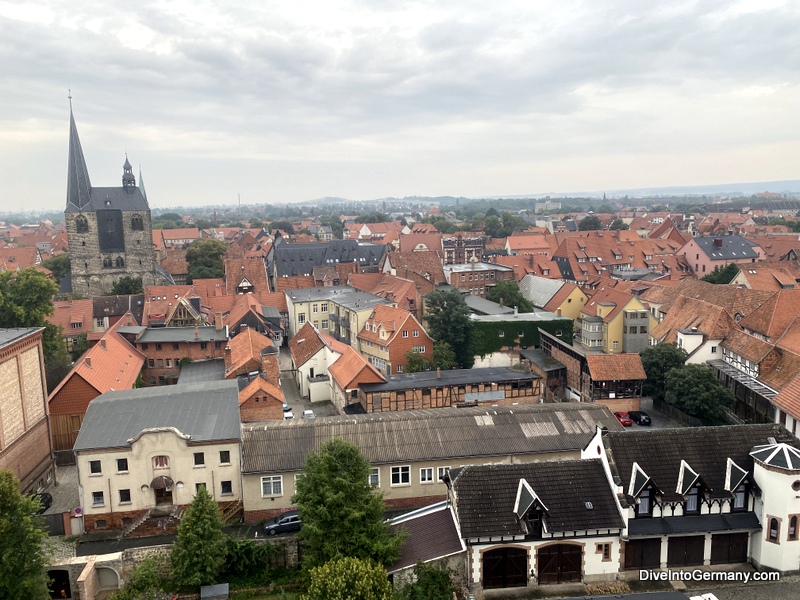
The tower is actually located in the grounds of the Schlosshotel zum Markgrafen so you need to enter here to climb this tower. This is easy to do, and you’ll spot it easily – it’s tall! So don’t feel strange about this.
There was a small charge of one Euro per person when we visited that we deposited into a turnstile to enter, so make sure you have enough Euro coins for your group.
Fachwerkmuseum Im Ständerbau (Half Timbered Museum)
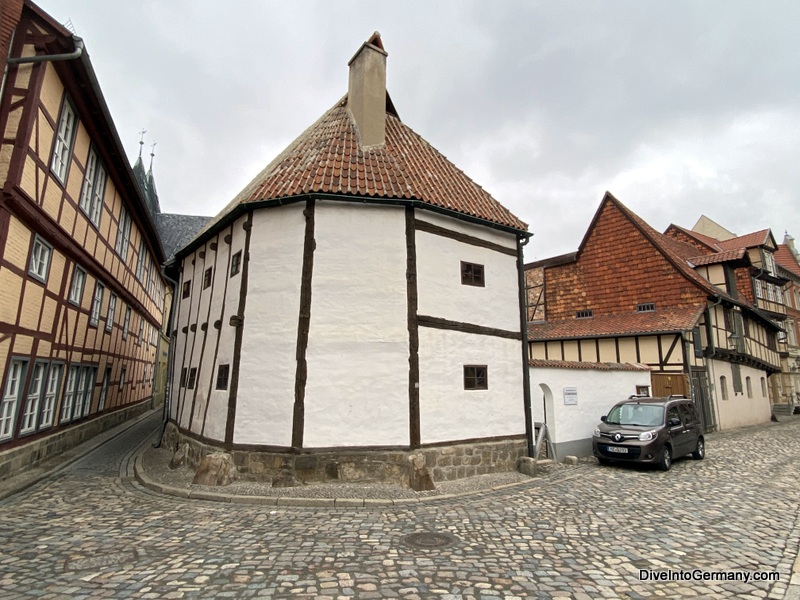
If you want to learn more about Germany’s half-timbered houses (it’s hard not to when you see so many of them here!), this museum is the place to head.
The Half Timbered Museum calls one of the oldest half-timbered houses in the city home. It dates back to 1310. It’s one of many styles you’ll see in Quedlinburg and this museum will walk you through the styles and physics behind the construction of these houses over time including the earliest Ständerbau construction (like this house).
You can also learn about the restoration currently taking place in Quedlinburg.
There is a small fee and this attraction usually shuts over winter.
We did not get the opportunity to visit this inside, but I think there’s a good chance it’s only in German.
Lyonel-Feininger-Galerie

For contemporary art, the Lyonel-Feininger-Galerie centres around the Bauhaus artist, Lyonel Feininger (1871–1956) and also shows work by some of his contemporaries.
Feininger was born in New York, but moved to Germany at the age of 16 before later returning to the US in 1937 to escape the Nazis. This collection is from the period 1906 to 1936 and was collected by Quedlinburg architect, Hermann Klumpp. It’s a collection of paintings, drawings, etchings, woodcuts, photographs and more.
It’s perfect for art lovers and a great contrast to the Medieval-ness of everything around 🙂
Klopstockhaus
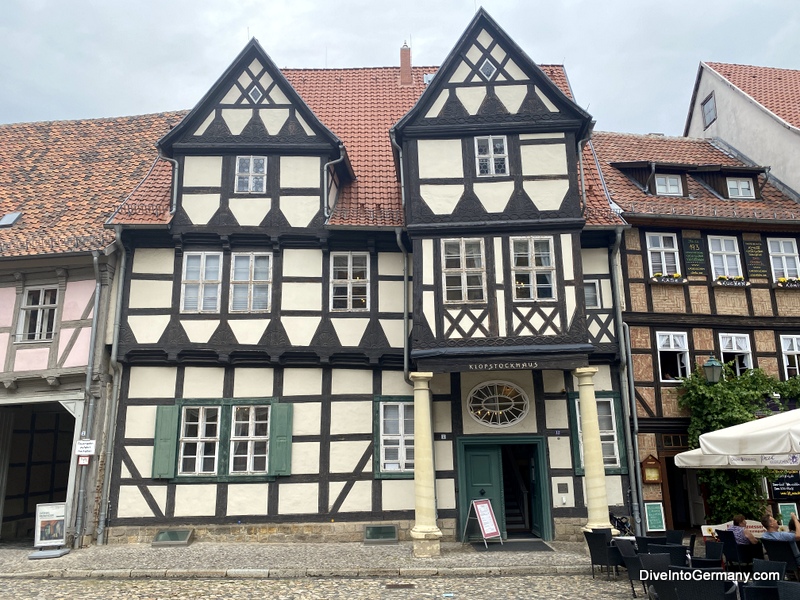
One of Quedlinburg’s favourite natives is the early classical poet, Friedrich Gottlieb Klopstock (1724–1803). Klopstockhaus is the home where he was born.
Today, it is a museum with exhibits centred around him and his work as well as other notable people born in Quedlinburg like Dorothea Erxleben (1715–62) who was Germany’s first female doctor.
Built just below Castle Hill around 1560, it is in a beautiful spot super close to the Lyonel-Feininger-Galerie. Take a walk here even if you don’t want to visit this museum.
Literary lovers will find it interesting the role Klopstock played in shaping poetry and the direction it was heading.
Schlossmuseum (Castle Museum)
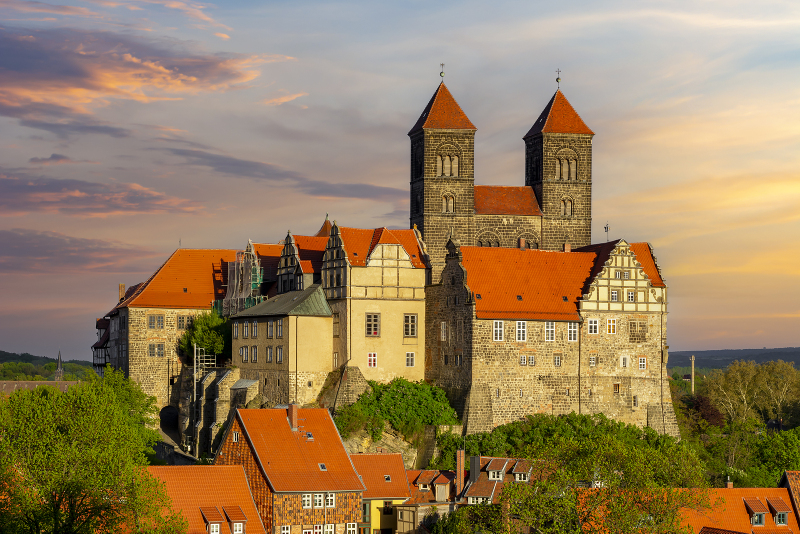
It’s time to take this Quedlinburg tour up from the Old Town to the old heart of Quedlinburg at Castle Hill (Schlossberg) with the Schlossmuseum which can be the first attraction you’ll hit here when walking from Marktplatz.
Castle Hill is a 25 metre high plateau located above Quedlinburg. Henry I initially had a church and residence here. Today, this Renaissance-era palace is home to the Schlossmuseum. This is the perfect place to head to learn more about the Quedlinburg’s history from prehistory and ancient and Medieval times.
You’ll learn more about how this area developed under Henry 1 and the Ottonian-period (919-1056) in particular. There are also remnants of stuccowork to see that date back to the 900s.
There’s also information about how the Nazi Party used this area and Henry I as part of their propaganda to justify their ideology.
There are also exhibits that date back to the bronze age found in nearby Lehof.
Add all of this with the fact that you also get to see the palace interiors, and it’s worth the entry fee.
Note at the time of publishing, this attraction is closed due to renovation work.
Stiftskirche St. Servatius (Collegiate Church)
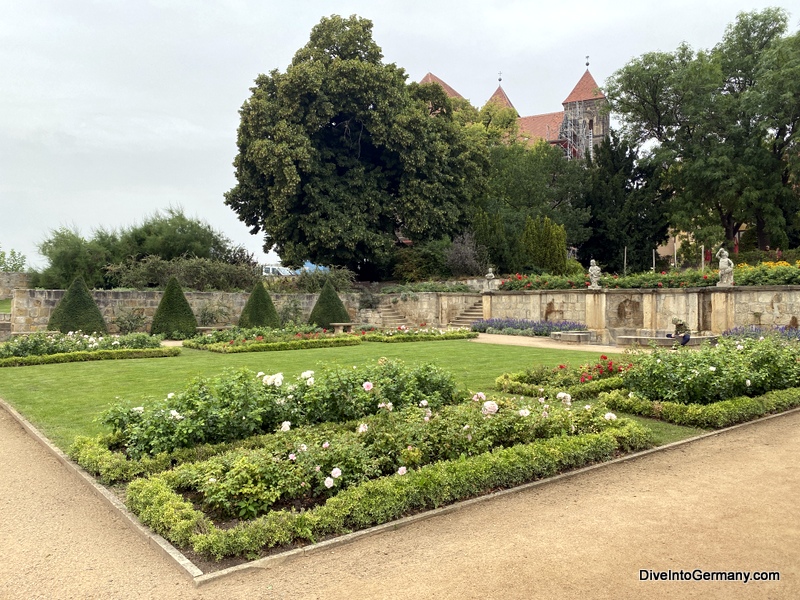
If you haven’t worked it out yet, Stiftskirche St. Servatius (Collegiate Church or formerly Quedlinburg Abbey) has played an important role in Quedlinburg’s history and should be high on your list of must visit places in Quedlinburg.
It was founded in 936 after Henry I died and his widow, Queen Mathilde, requested it in his honour. For centuries, this church and its abbesses had power and influence.
This sandstone building makes for quite a sight and you’ll want to make your way up here on Castle Hill. Its Lombard Romanesque architecture looks grand and imposing on the hill.
Inside, there are many treasures.
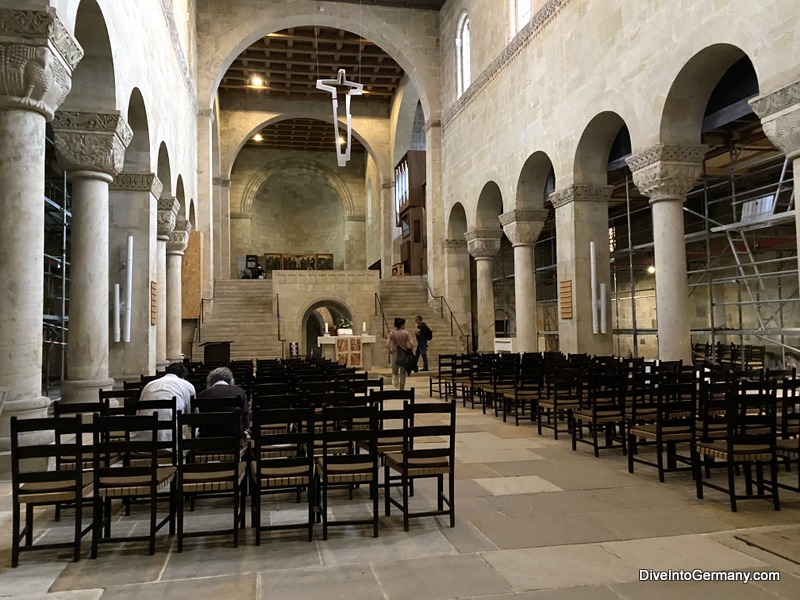
Firstly, Henry I and his wife, Mathilde, are buried here as well as the former abbesses. Its crypt also has many other treasures including murals, reliquaries and early Bibles. UNESCO says it “constitutes one of the most significant monuments in the history of art from the 10th to the 12th century”.
There is also a treasury reached from the choir with preserved Medieval treasure art. The wealth of this church at the time can be seen in the relics, manuscripts, sculptures, paintings and more here including great goldsmith work and ivory carvings. You can also find the oldest preserved knotted carpet in Europe from around 1200, and plenty of items much older than this.
As a history buff, I very much enjoyed visiting such an old church that stands at such an historic place, and I highly recommend it.
There is an entry fee (around 5 euros when we visited) but it’s well worth it.
Münzenberg
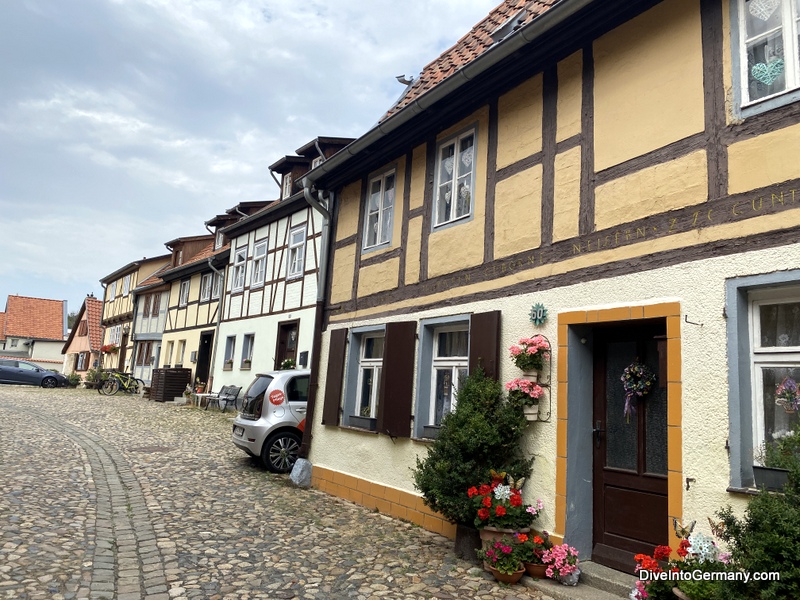
Münzenberg is an area of Quedlinburg on the hill to the west of the Old Town. It was once a separate settlement started when the sister of Otto II, Abbess Mathilde, and his wife founded a monastery church here. It is also home to around 65 half-timbered houses.
The monastery was closed when the Protestant Reformation took place and the treasures were moved to the Collegiate Church. Over time, the ruins were built over.
Today, you can find preserved parts of the building to give you an idea of the Medieval architecture that this building had. This is thanks to Professor Siegfried Behrens and his wife who bought the houses that were over the church and reunited the area so you can see everything that is left now.
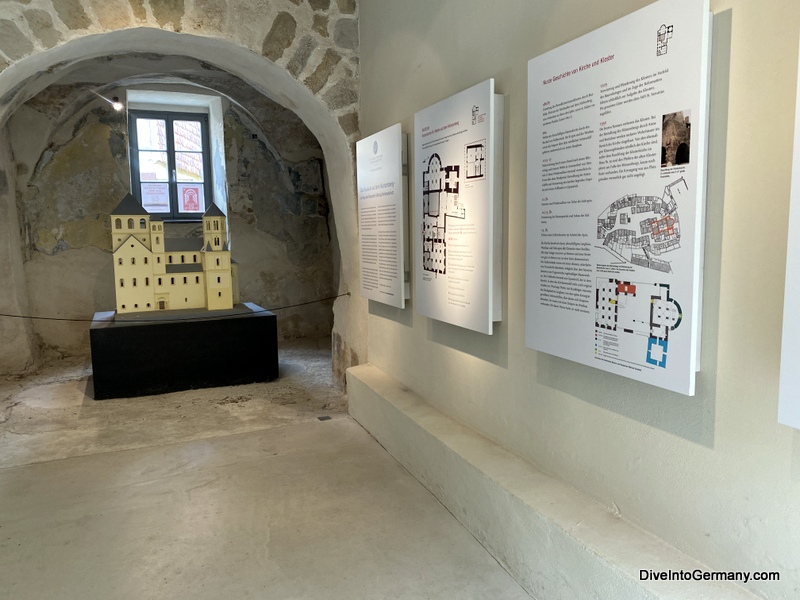
There is a museum on this site that you can visit for free. Information is in German only. Find the latest opening hours here.
Even if you don’t visit the museum, it’s a pretty little area to stroll and enjoy which is just a short walk from the heart of the Old Town. There are some nice views over to the Old Town as well. Even better is that I had it all to myself on a Friday in August.
Harz Narrow Gauge Railway
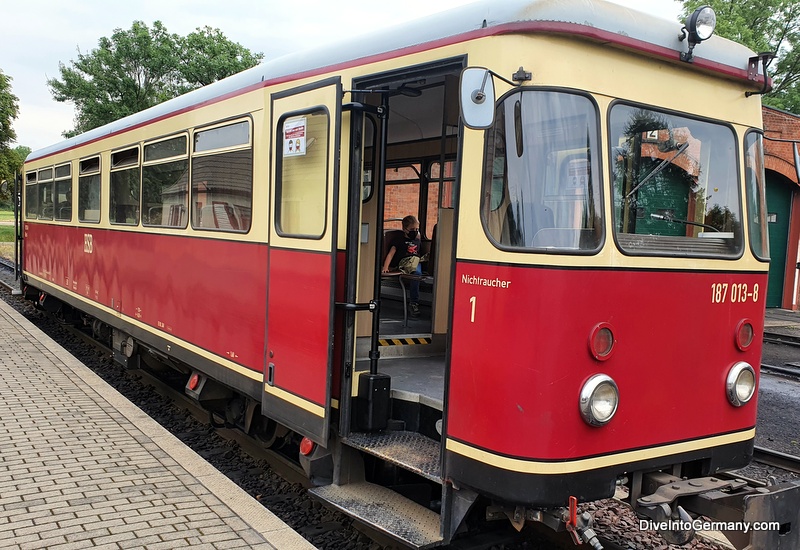
For something completely different to do in Quedlinburg, consider seeing more of the Harz Mountains on the narrow gauge railway.
Quedlinburg is the terminus for the Selktealbahn line that goes into the Harz Mountains via Bad Suderode, Gernrode, Alexisbad and Stiege. Depending on the train you catch, you can see the Harz Mountains from a train carriage pulled by a steam engine, diesel engine or a motor railcar, all of them offering excellent views.
You can also change trains and ride on the other two lines in the network at the stations where the lines meet. Train lovers won’t want to miss the chance to ride on the largest narrow gauge network in Germany.
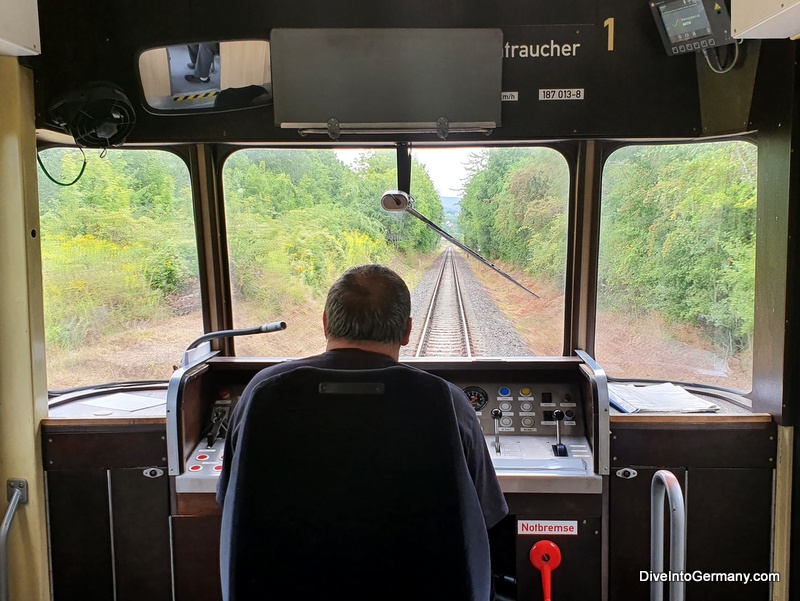
Even if you’re not a train buff, the train makes for a great day trip from Quedlingburg.
You can buy tickets online or at the tourist information centre on the Marktplatz. You select your origin and destination (and one way or return) and your tickets are valid for any trains on between those points for the day of travel. Buy tickets online or find timetables and more information here.
Best Things To Do In Quedlinburg In December
While most of the things to see in Quedlinburg Germany listed above are possible in winter time, there are also some fun things to do in Quedlinburg which are especially for the winter months.
Note that the Half Timbered Museum shuts in winter.
Quedlinburg Christmas Market And Other Events
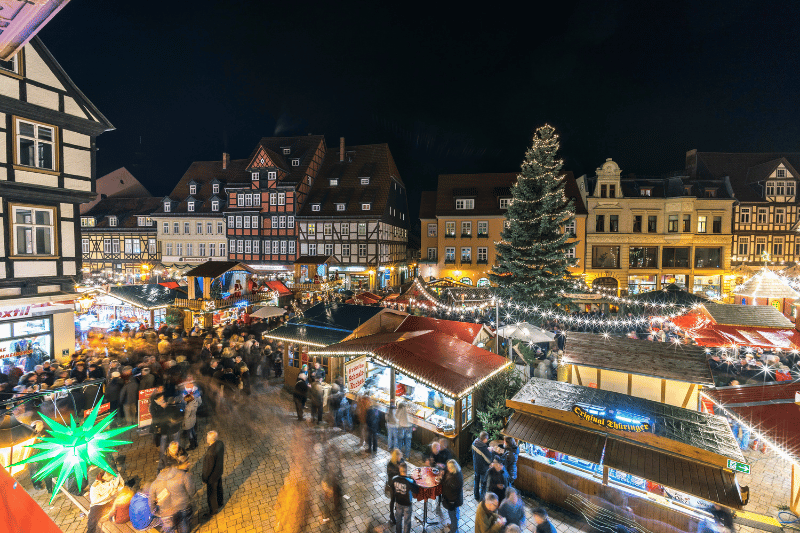
The Quedlinburg Christmas Market runs for about a month in the lead up to Christmas. It’s the perfect place to head if you are in Quedlinburg at this time for some festive spirit, to buy Christmas gifts and crafts and to try local food. Head to Marktplatz to get started
Even more special is the “Advent in the Courtyards”. On the second and third weekends of Advent, 20+ inner courtyards in Quedlinburg, which are usually not publicly accessible, open up. Small treasures are offered in the courtyards especially made for these weekends.
There is also the “largest Advent calendar in Germany”. Every day in December in the lead up to Christmas, one of 24 houses around Castle Hill with special Christmas decorations is opened to the public. Each day at 4:30pm outside of Klopstockhaus, everyone taking part meets and then searches together for the house that is opening that day. It has a shining star on the door.
Inside, there are surprises. This is an event aimed at families.
There is a great video explaining it here. It’s on our list for next time we spend Christmas in Germany!
What To Do In Quedlinburg In One Day
Only have one day in Quedlinburg? What a shame! But it’s ok, it’s still worth going to Quedlinburg if you only have one day.
With one day, I recommend you stick to the Old Town. In a day, you can have a good wander and visit most the attractions mentioned above without rushing around too much. In fact, they mostly fit nicely into a day.
You can make your own itinerary by picking the places to visit in Quedlinburg that sound most interesting to you or you can copy my itinerary below.
- Start at Marktplatz. Take your time soaking it all in and checking out the exterior of the Rathaus
- Take a look at the Market Church Of St Benedict
- Climb up Sternkiekerturm for great views over the Old Town
- Walk towards the Fachwerkmuseum Im Ständerbau (Half Timbered Museum) taking any detours you feel like on the way
- Visit either the Lyonel-Feininger-Galerie or Klopstockhaus depending on whether you are prefer art or literary history
- Walk up to Schlossmuseum and explore the palace
- Go inside Stiftskirche St. Servatius and give yourself enough time to fully enjoy everything on offer
If you still have time, wander around Münzenberg.
Quedlinburg Attractions Map

Best Place To Stay In Quedlinburg
When it comes to where to stay in Quedlinburg, there is a great range of hotels and other accommodation options. You won’t have any problem finding somewhere to stay.
Below, I’ve listed a few different places to consider depending on what type of accommodation you are looking for.
If you want more options, you can use this map to help you find hotels and home rental accommodation around Quedlinburg.
BEST – Romantik Hotel am Brühl Review
Located just south of Castle Hill, you can easily explore Quedlinburg from this stylish hotel just outside the Old Town.
Facilities here include a great restaurant with evening meals and afternoon cake time. There is also a bar and they can pack a lunch for you. Buffet breakfast is usually included in the accommodation charge.
Parking is possible for an additional charge as is access to a sauna. Wifi internet is included.
There are a range of room types from singles, doubles, triples and suites to two bedroom apartments. So, despite the name, this is a good choice for families as well as couples.
Rooms include flat-screen TV, minibar, toiletries and a desk area at a minimum. The apartments have living rooms and kitchenettes. All are beautifully renovated and stylishly decorated.
Click here for the latest prices.
VALUE – Hotel Zum Brauhaus Review
Looking for a lower price and great value? Consider the Hotel Zum Brauhaus. Located in the Old Town in between Castle Hill and Marktplatz, this is in a fabulous spot.
Facilities include free parking, included breakfast and wifi.
Rooms are either single or double but you can also book a triple room which is a connecting single and double room. Rooms include flat-screen TV, ensuite bathroom and desk area. The rooms can be quite small.
Click here for the latest prices.
APARTMENTS – Quartier Am Brunnen Review

The Quartier am Brunnen is well located and a perfect choice if you want apartment style accommodation in the heart of the Old Town, moments from Marktplatz and Castle Hill. The hotel is in a renovated Baroque half-timbered house and it’s very atmospheric.
There are a range of apartments that are mostly one-bedroom as well as a two bedroom apartment complete with a great patio that can house up to six people. The apartments are self catering and great value.
You can find free parking and wifi internet here as well as an optional breakfast. There is also a garden area.
Click here for the latest prices or you can read our full review here.
How To Get To Quedlinburg
We travelled to Quedlinburg by hire car which made it very easy to get here.
You can hire a car to get you there by clicking here.
Quedlinburg is on the Romanesque Road which is a tourist route you may enjoy exploring. It takes you on a journey to towns with significant Romanesque architecture.
There are regular trains and buses here. You can find timetables and all your options here. From the main cities in the area, like Berlin and Leipzig, you’ll usually need to take multiple trains with changes in places like Magdeburg or Halberstadt. There are direct buses from Berlin.
If you want to fly here, Leipzig, Hanover and Berlin are your best choices, although they aren’t that close.
Once in Quedlinburg, we found it easy to explore on foot. Many roads are pedestrian only and you won’t want to miss anything by exploring any other way!
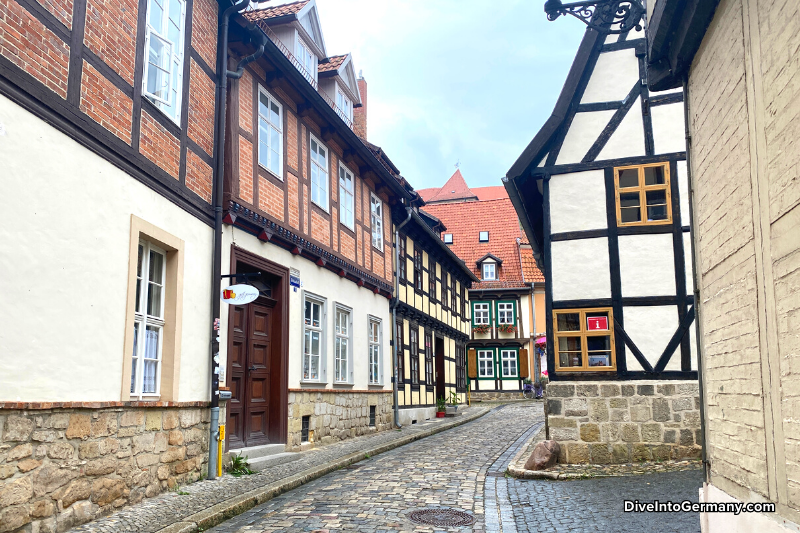
Quedlinburg With Kids
We visited Quedlinburg with our six and ten year olds. We found it a great place to visit with kids because most of what we wanted to do was simply walk around the Old Town which worked well for them. They had fun trying to find different coloured houses and picking their favourite ones.
If your kid is tired or reluctant to walk around much, you could take one of the train tours here around the Old Town.
There are playgrounds in the Wordgarten and in the Brühlpark (enter at Platz des Friedens) which are both by Castle Hill.
Final Words
I hope you enjoyed this guide to Quedlinburg and find it useful. Quedlinburg is a picturesque place to visit which is perfect for anyone who enjoys history and stunning Old Towns.
While there are some great attractions here (particularly the Collegiate Church), the best part is simply walking around the old streets taking it all in.
It’s a must visit for anyone who enjoys gorgeous Old Towns and history.
Add it to your Germany itinerary now!
Read more guides to visiting Central Germany here. Or read this guide to nearby Bamberg here or Leipzig here. Don’t miss our amazing Central Germany itinerary here which includes Quedlinburg.


